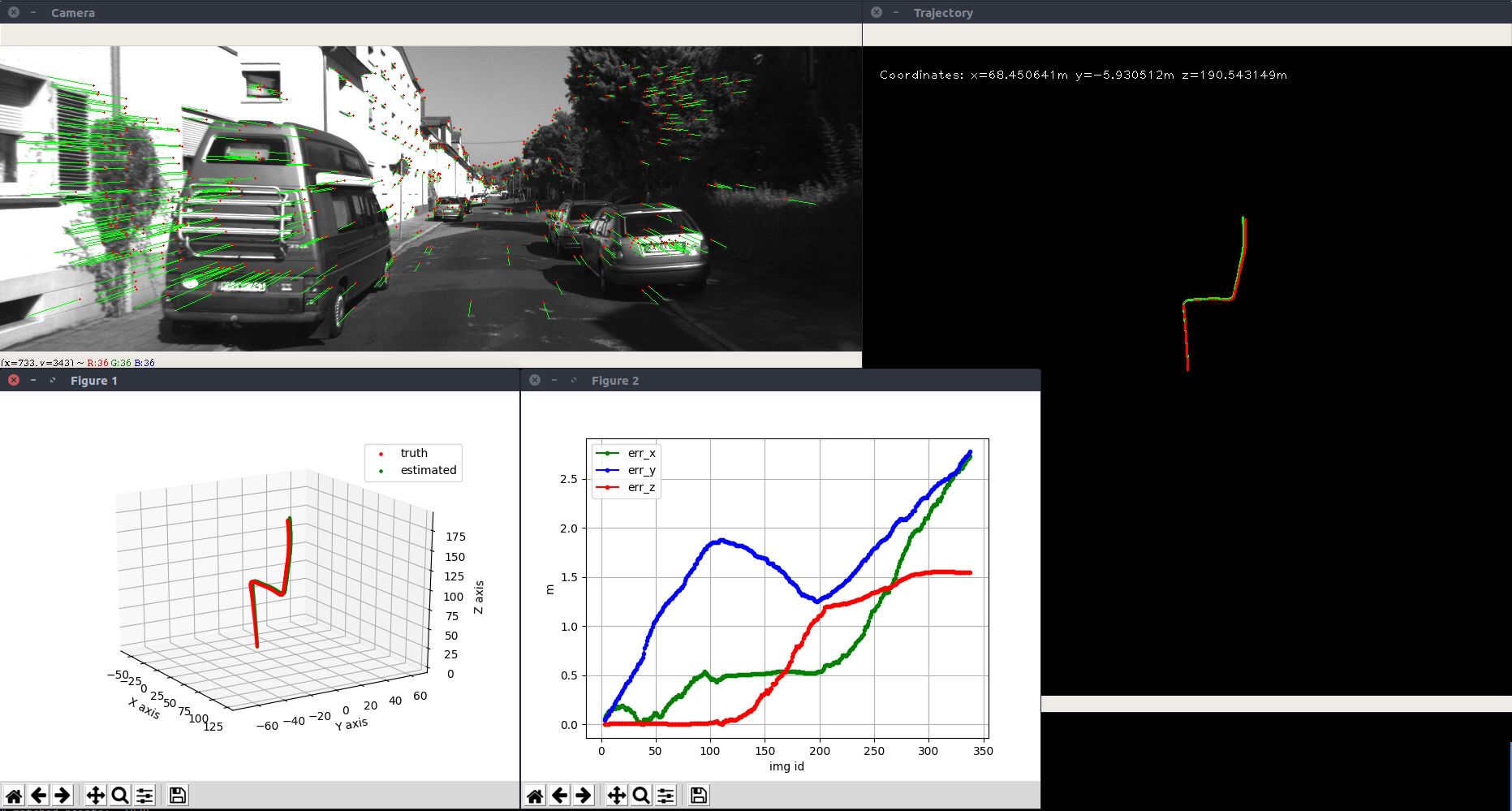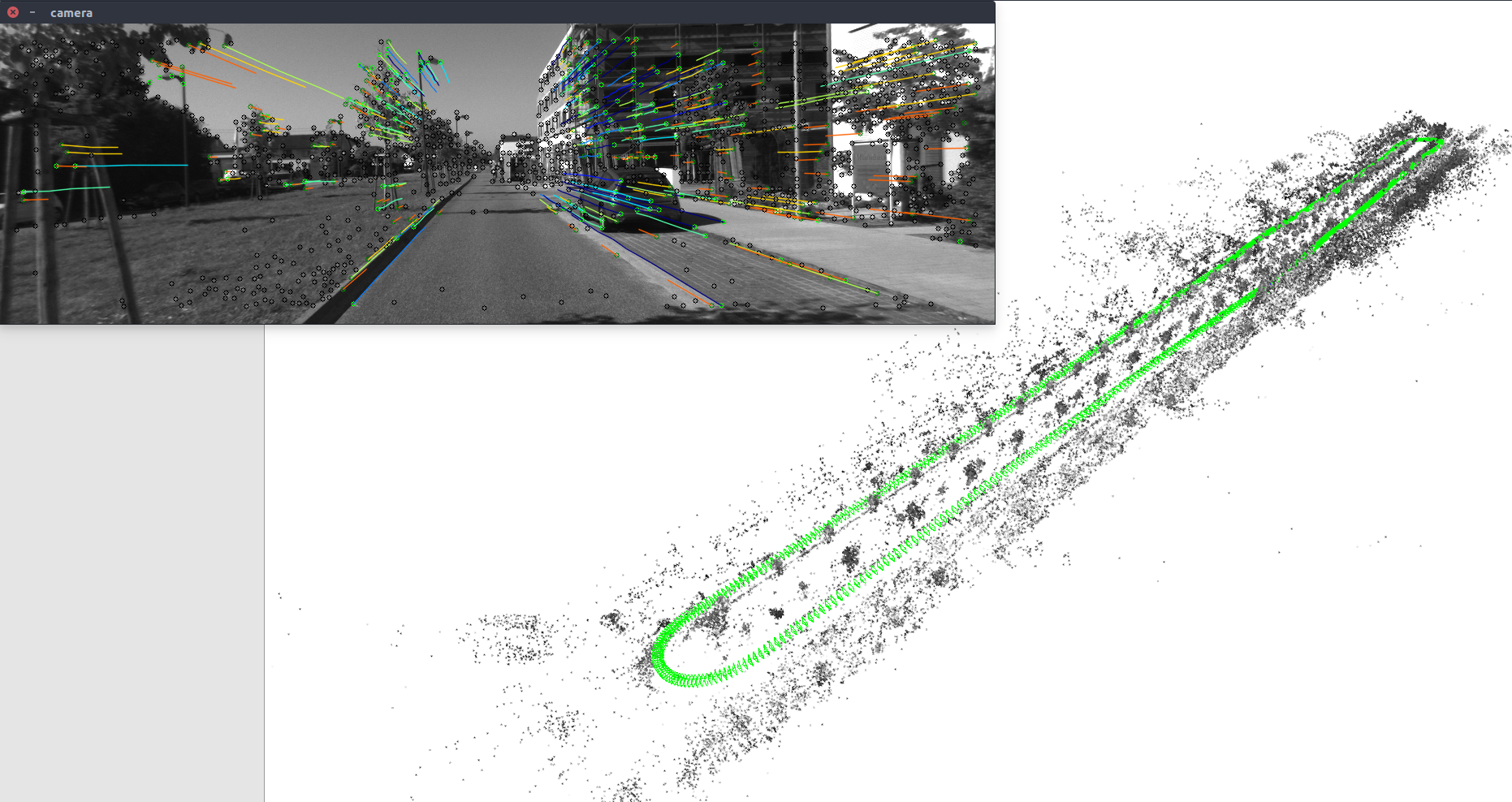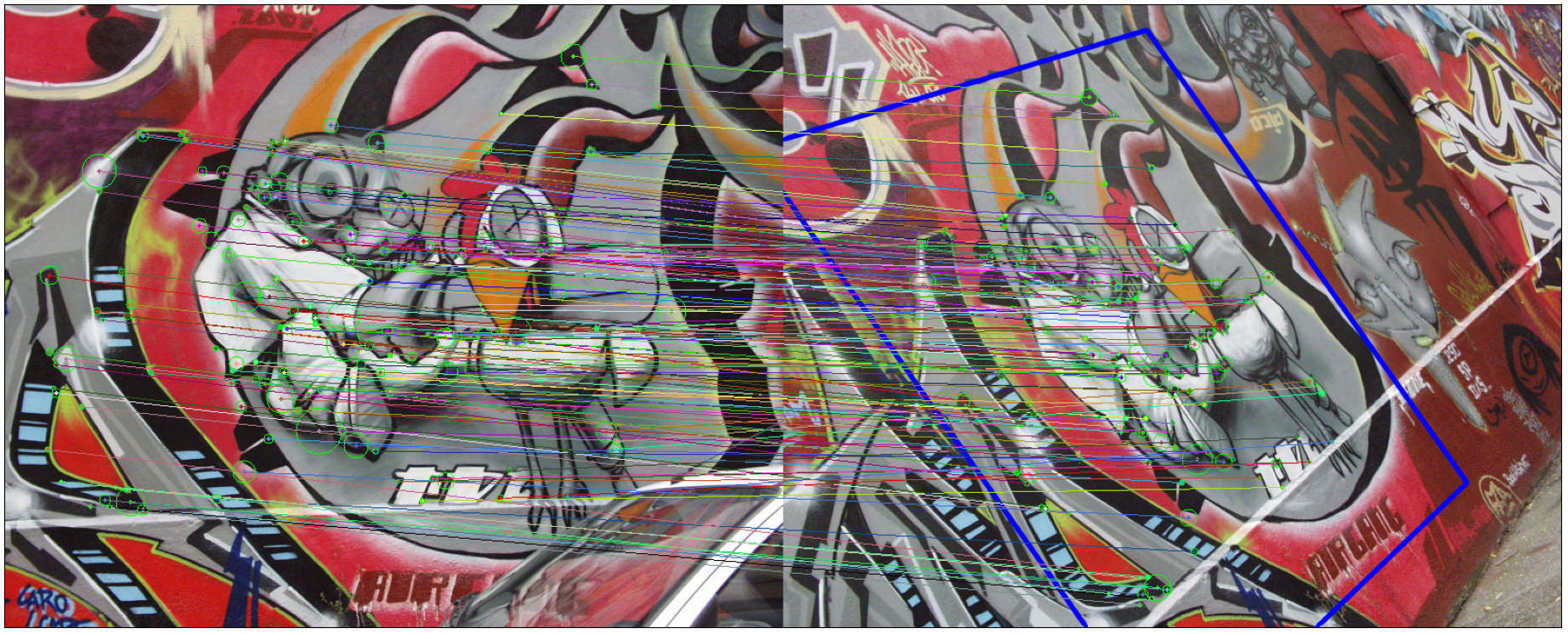Author: Luigi Freda
pySLAM contains a python implementation of a monocular Visual Odometry (VO) pipeline. It supports many classical and modern local features, and it offers a convenient interface for them. Moreover, it collects other common and useful VO and SLAM tools.
I released pySLAM v1 for educational purposes, for a computer vision class I taught. I started developing it for fun as a python programming exercise, during my free time, taking inspiration from some repos available on the web.
Main Scripts:
-
main_vo.pycombines the simplest VO ingredients without performing any image point triangulation or windowed bundle adjustment. At each step$k$ ,main_vo.pyestimates the current camera pose$C_k$ with respect to the previous one$C_{k-1}$ . The inter-frame pose estimation returns$[R_{k-1,k},t_{k-1,k}]$ with$||t_{k-1,k}||=1$ . With this very basic approach, you need to use a ground truth in order to recover a correct inter-frame scale$s$ and estimate a valid trajectory by composing$C_k = C_{k-1} * [R_{k-1,k}, s t_{k-1,k}]$ . This script is a first start to understand the basics of inter-frame feature tracking and camera pose estimation. -
main_slam.pyadds feature tracking along multiple frames, point triangulation, keyframe management and bundle adjustment in order to estimate the camera trajectory up-to-scale and build a map. It's still a VO pipeline but it shows some basic blocks which are necessary to develop a real visual SLAM pipeline.
You can use this framework as a baseline to play with local features, VO techniques and create your own (proof of concept) VO/SLAM pipeline in python. When you test it, consider that's a work in progress, a development framework written in Python, without any pretence of having state-of-the-art localization accuracy or real-time performances.
Enjoy it!
Clone this repo and its modules by running
$ git clone --recursive https://github.com/luigifreda/pyslam.git
The framework has been developed and tested under Ubuntu 18.04.
A specific install procedure is available for:
I am currently working to unify the install procedures.
Requirements:
- Python 3.6.9
- Numpy (1.18.2)
- OpenCV (see below for a suggested python installation)
- PyTorch (>= 1.4.0)
- Tensorflow-gpu 1.14.0
If you run into troubles or performance issues, check this file.
If you want to launch main_vo.py, run the script:
$ ./install_basic.sh
in order to automatically install the basic required system and python3 packages. Here, pip3 is used.
If you want to run main_slam.py, you must additionally install the libs pangolin, g2opy, etc. by running:
$ ./install_all.sh
If you do not want to mess up your working python environment, you can create a new virtual environment pyslam by easily launching the scripts described here.
If you prefer conda, run the scripts described in this other file.
N.B.: you just need a single python environment to be able to work with all the supported local features!
If you use conda, follow the instructions reported in this file. On the other hand, if you want to use a new virtual environment, then move into the experimental branch ubuntu20
$ git checkout ubuntu20
and then follow the instructions here.
Check the instructions in this file.
In order to use non-free OpenCV features (i.e. SIFT, SURF, etc.), you need to install the module opencv-contrib-python. The script install_pip3_packages.sh takes care of installing the proper version. This module can be installed by running
$ pip3 uninstall opencv-contrib-python
$ pip3 install opencv-contrib-python==3.4.2.16
How to check your installed OpenCV version:
$ python3 -c "import cv2; print(cv2.__version__)"
For a more advanced OpenCV installation procedure, you can take a look here.
If you run into issues or errors during the installation process or at run-time, please, check the file TROUBLESHOOTING.md.
Once you have run the script install_basic.sh, you can immediately run:
$ python3 -O main_vo.py
This will process a KITTI video (available in the folder videos) by using its corresponding camera calibration file (available in the folder settings), and its groundtruth (available in the same videos folder). You can stop main_vo.py by focusing on the Trajectory window and pressing the key 'Q'.
N.B.: as explained above, the basic script main_vo.py strictly requires a ground truth.
In order to process a different dataset, you need to set the file config.ini:
- select your dataset
typein the section[DATASET](see the section Datasets below for further details) - the camera settings file accordingly (see the section Camera Settings below)
- the groudtruth file accordingly (ee the section Datasets below and check the files
ground_truth.pyandconvert_groundtruth.py)
Once you have run the script install_all.sh (as required above), you can test main_slam.py by running:
$ python3 -O main_slam.py
This will process a KITTI video (available in the folder videos) by using its corresponding camera calibration file (available in the folder settings). You can stop it by focusing on the opened Figure 1 window and pressing the key 'Q'.
You can choose any detector/descriptor among ORB, SIFT, SURF, BRISK, AKAZE, SuperPoint, etc. (see the section Supported Local Features below for further information).
Some basic test/example files are available in the subfolder test. In particular, as for feature detection/description/matching, you can start by taking a look at test/cv/test_feature_manager.py and test/cv/test_feature_matching.py.
N.B.:: due to information loss in video compression, main_slam.py tracking may peform worse with the available KITTI videos than with the original KITTI image sequences. The available videos are intended to be used for a first quick test. Please, download and use the original KITTI image sequences as explained below.
At present time, the following feature detectors are supported:
- FAST
- Good features to track
- ORB
- ORB2 (improvements of ORB-SLAM2 to ORB detector)
- SIFT
- SURF
- KAZE
- AKAZE
- BRISK
- AGAST
- MSER
- StarDector/CenSurE
- Harris-Laplace
- SuperPoint
- D2-Net
- DELF
- Contextdesc
- LFNet
- R2D2
- Key.Net
The following feature descriptors are supported:
- ORB
- SIFT
- ROOT SIFT
- SURF
- AKAZE
- BRISK
- FREAK
- SuperPoint
- Tfeat
- BOOST_DESC
- DAISY
- LATCH
- LUCID
- VGG
- Hardnet
- GeoDesc
- SOSNet
- L2Net
- Log-polar descriptor
- D2-Net
- DELF
- Contextdesc
- LFNet
- R2D2
You can find further information in the file feature_types.py. Some of the local features consist of a joint detector-descriptor. You can start playing with the supported local features by taking a look at test/cv/test_feature_detector.py and test/cv/test_feature_matching.py.
In both the scripts main_vo.py and main_slam.py, you can create your favourite detector-descritor configuration and feed it to the function feature_tracker_factory(). Some ready-to-use configurations are already available in the file feature_tracker.configs.py
The function feature_tracker_factory() can be found in the file feature_tracker.py. Take a look at the file feature_manager.py for further details.
N.B.: you just need a single python environment to be able to work with all the supported local features!
You can use 4 different types of datasets:
| Dataset | type in config.ini |
|---|---|
| KITTI odometry data set (grayscale, 22 GB) | type=KITTI_DATASET |
| TUM dataset | type=TUM_DATASET |
| video file | type=VIDEO_DATASET |
| folder of images | type=FOLDER_DATASET |
pySLAM code expects the following structure in the specified KITTI path folder (specified in the section [KITTI_DATASET] of the file config.ini). :
├── sequences
├── 00
...
├── 21
├── poses
├── 00.txt
...
├── 10.txt
-
Download the dataset (grayscale images) from http://www.cvlibs.net/datasets/kitti/eval_odometry.php and prepare the KITTI folder as specified above
-
Select the corresponding calibration settings file (parameter
[KITTI_DATASET][cam_settings]in the fileconfig.ini)
pySLAM code expects a file associations.txt in each TUM dataset folder (specified in the section [TUM_DATASET] of the file config.ini).
-
Download a sequence from http://vision.in.tum.de/data/datasets/rgbd-dataset/download and uncompress it.
-
Associate RGB images and depth images using the python script associate.py. You can generate your
associations.txtfile by executing:
$ python associate.py PATH_TO_SEQUENCE/rgb.txt PATH_TO_SEQUENCE/depth.txt > associations.txt
- Select the corresponding calibration settings file (parameter
[TUM_DATASET][cam_settings]in the fileconfig.ini)
The folder settings contains the camera settings files which can be used for testing the code. These are the same used in the framework ORBSLAM2. You can easily modify one of those files for creating your own new calibration file (for your new datasets).
In order to calibrate your camera, you can use the scripts in the folder calibration. In particular:
- use the script
grab_chessboard_images.pyto collect a sequence of images where the chessboard can be detected (set the chessboard size therein, you can use the calibration patterncalib_pattern.pdfin the same folder) - use the script
calibrate.pyto process the collected images and compute the calibration parameters (set the chessboard size therein)
For further information about the calibration process, you may want to have a look here.
If you want to use your camera, you have to:
- calibrate it and configure WEBCAM.yaml accordingly
- record a video (for instance, by using
save_video.pyin the foldercalibration) - configure the
[VIDEO_DATASET]section ofconfig.iniin order to point to your video.
I would be very grateful if you would contribute to the code base by reporting bugs, leaving comments and proposing new features through issues and pull requests. Please feel free to get in touch at luigifreda(at)gmail[dot]com. Thank you!
Suggested books:
- Multiple View Geometry in Computer Vision by Richard Hartley and Andrew Zisserman
- An Invitation to 3-D Vision by Yi-Ma, Stefano Soatto, Jana Kosecka, S. Shankar Sastry
- Computer Vision: Algorithms and Applications, by Richard Szeliski
- Deep Learning, by Ian Goodfellow, Yoshua Bengio and Aaron Courville
- Neural Networks and Deep Learning, By Michael Nielsen
Suggested material:
- Vision Algorithms for Mobile Robotics by Davide Scaramuzza
- CS 682 Computer Vision by Jana Kosecka
- ORB-SLAM: a Versatile and Accurate Monocular SLAM System by R. Mur-Artal, J. M. M. Montiel, and J. D. Tardos
- Double Window Optimisation for Constant Time Visual SLAM by H. Strasdat, A. J. Davison J.M.M. Montielb, K. Konolige
- The Role of Wide Baseline Stereo in the Deep Learning World by Dmytro Mishkin
- To Learn or Not to Learn: Visual Localization from Essential Matrices by Qunjie Zhou, Torsten Sattler, Marc Pollefeys, Laura Leal-Taixe
- Awesome local-global descriptors repository
Moreover, you may want to have a look at the OpenCV guide or tutorials.
- Pangolin
- g2opy
- ORBSLAM2
- SuperPointPretrainedNetwork
- Tfeat
- Image Matching Benchmark Baselines
- Hardnet
- GeoDesc
- SOSNet
- L2Net
- Log-polar descriptor
- D2-Net
- DELF
- Contextdesc
- LFNet
- R2D2
- Key.Net
- Twitchslam
- MonoVO
Many improvements and additional features are currently under development:
- loop closure
- relocalization
- map saving/loading
- modern DL matching algorithms
- object detection and semantic segmentation
- 3D dense reconstruction


